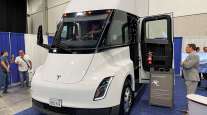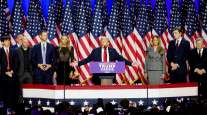Tesla Delays Production of Semi Truck Until 2020

SAN FRANCISCO — Chief Financial Officer Zachary Kirkhorn hinted on a quarterly earnings call that Tesla will build its new semi starting in 2020 at its factory near Reno, Nev.
That’s where the battery and electric drive units will be made, he said. Tesla began taking orders for the Semi in November 2017 with a $150,000 base price for a tractor with a 300-mile range and an $180,000 base price for a version with a 500-mile range. It previously had said it would begin production this year.
Meanwhile, CEO Elon Musk said the company will decide in the next few weeks whether it will build the Model Y small SUV in Nevada or at its Fremont, Calif., factory. Deliveries are scheduled to start in the fall of 2020.

Tesla CEO Elon Musk speaks before unveiling the Model Y at the company's design studio in Hawthorne, Calif., in March of 2019. (Jae C. Hong/Associated Press)
Musk had prepped Wall Street for a first-quarter loss, but analysts still were stunned by its size: $702.1 million, among the company’s worst quarters in the past two years.
The net loss was more than double what analysts had predicted as Tesla’s sales slumped 31% for the quarter. The loss of $4.10 per share left Musk spending much of a conference call explaining how it happened. But he also extolled his forecast that demand and profit margins will increase as Tesla rolls out updated products and pricing for its three models, and sells more battery storage units.
Demand for Tesla’s Models S, X and 3 is returning to normal in the second quarter after the company delivered only 63,000 vehicles from January through March, Musk said.
“My impression right now is that demand is quite solid, quite strong,” he said April 24.
He predicted another loss in the second quarter but said Tesla would be back in the black in the third quarter. The first-quarter loss came after two consecutive profitable quarters, the first time that’s happened in Tesla’s 15-year history.
The company said that due to “unforeseen challenges” it was only able to deliver half of the vehicles ordered in the quarter by March 31 as it ramped up deliveries in Europe and China. That pushed a large number of deliveries, and revenue, into the current quarter, it said.
Tesla’s cash balance at the end of the quarter shrunk by $1.5 billion since December, to $2.2 billion. The company attributed the decline to a $920 million bond payment, and Musk said it might be time for Tesla to raise capital again.
The company still expects to produce 360,000 to 400,000 vehicles this year, and if a new Chinese factory hits volume production at the end of the year, it could make 500,000.
Tesla likely is nearing its “cash floor,” the amount it needs in the checking account to pay all the bills, Gartner analyst Michael Ramsey said.
“It’s anxiety-provoking,” Ramsey said.
If Tesla continues burning cash at the first-quarter rate, it would run out of money in less than six months.
But Ramsey said that’s not likely. If Tesla can produce and sell all the vehicles that it predicts in the current quarter, it will generate a lot of cash, easing its problem. Tesla said it believes deliveries will hit 90,000 to 100,000 vehicles from April through June.




